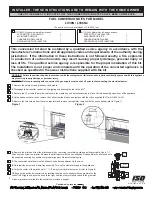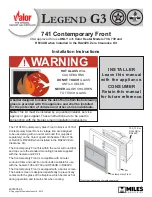
21
17. The flue collar, with a 180 mm diameter, allows connecting the appliance to the duct or
flexible chimney hose.
2.2.
Operation
Air flow
It is also important to understand how the different air flows are organised in and around the
appliance.
A Cold convection air
B Hot convection air
C Primary air through distribution flap
D Secondary air
E Smoke extraction air (glass pane)
F Smoke
Convection air enters the appliance through the filter integrated into the wicket door. It is set in
motion by the 2 tangential fans. The air is then heated up by the heating element and several
heat exchangers.
Hot air exits above the door and through the hot air outlets if they are connected.
Hot air ducts are not necessary, but they do help better distribute the heat throughout the
home. Two flaps allow the amount of air supplied to the hot air ducts to be adjusted. Use the
supplied tool (bent round rod) to change the position of the dampers.
The primary air is managed by the Easy system and is used to stoke the fire. It is introduced in
the lower part of the fireplace, in the bed of embers, to start and stimulate combustion.
The secondary air is warmed up by the heating element and blown in at a height of about 20
cm, just above the combustible material, to complete the combustion. It allows a complete and
clean combustion of the wood.
The smoke extraction air is also preheated by the heating element and blown to the top of the
glass pane. This air ensures that the glass pane is kept clean while the appliance is operated. It
also acts as secondary air.
The fumes are evacuated at the top, through the baffles. They slow down the combustion gases,
to allow heat transfer to the heating element and heat exchangers. The correct adjustment of
the baffle is essential for the correct operation of the appliance.
Opening and closing of the door
To open the door, insert the handle into the hole located at the centre of the right-hand side of
the door. Raise the handle as high as possible and open the door.
















































